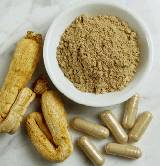- Navigating Your Midlife Crisis: Embracing New Possibilities
- City Raccoons Showing Signs of Domestication
- Mapping the Exposome: Science Broadens Focus to Environmental Disease Triggers
- One Week Less on Social Media Linked to Better Mental Health
- Your Brain Changes in Stages as You Age, Study Finds
- Some Suicide Victims Show No Typical Warning Signs, Study Finds
- ByHeart Formula Faces Lawsuits After Babies Sickened With Botulism
- Switch to Vegan Diet Could Cut Your Greenhouse Gas Emissions in Half
- Regular Bedtime Does Wonders for Blood Pressure
- Dining Alone Could Mean Worse Nutrition for Seniors
High-Fiber Diet May Aid Heart Attack Survivors


Heart attack survivors who get the recommended amount of fiber in their diets may live longer, a new study suggests.
Many studies have found that fiber lovers tend to have a lower risk of developing heart disease in the first place. Experts said the new findings suggest fiber — especially from whole grains — has benefits after a heart attack as well.
Researchers found that of more than 4,000 U.S. adults who’d suffered a first-time heart attack, those who ate plenty of fiber were less likely to die over the next decade.
And fiber from grains seemed particularly important, the researchers reported April 29 in the online edition of BMJ.
People who ate the most “cereal fiber” — from foods like oatmeal, barley and whole-wheat pasta — were 27 percent less likely to die during the study period, versus those who ate the least.
The findings do not prove that fiber, itself, prolongs heart attack survivors’ lives. People who eat high-fiber foods may differ in many ways from those who get little fiber.
And the study could not account for all of those potential differences, said Eric Rimm, an associate professor at the Harvard School of Public Health and the senior researcher on the work.
But all of the heart attack survivors in the study were doctors, nurses or other health professionals — a fairly homogenous group, the researchers noted. They also accounted for factors such as people’s medication use, exercise habits and weight.
The take-home message, Rimm said, is that “heart attack survivors might consider consuming more foods that are high in fiber, including whole grains, fruits and vegetables.”
In general, experts recommend that women get around 25 grams of fiber each day, while men should strive for 38 grams. The current findings suggest that could be enough to benefit heart attack survivors: Men in the top 20 percent for fiber intake averaged 37 grams per day after their heart attack, while their female counterparts averaged 29 grams a day.
Over almost a decade, those men and women were about one-quarter less likely to die, versus heart attack survivors in the bottom 20 percent for fiber intake — who averaged 12 grams to 16 grams of fiber per day.
When Rimm’s team took a closer look at the sources of that fiber, only fiber from grains was statistically linked to a lower risk of death from heart disease, or any cause.
So does that mean only foods like oatmeal and brown rice matter? No, Rimm said. He suggested that heart attack survivors aim for a “high-quality” diet with plenty of whole grains, fruits and vegetables.
Those foods are not only rich in fiber, Rimm said, but also contain important minerals, vitamins and plant chemicals.
A preventive cardiologist who reviewed the study said it drives home the point that not all carbohydrates are alike — and fiber-rich whole grains are not the same as the refined carbs in processed foods.
“I think carbs, in general, have a bad name,” said Dr. Suzanne Steinbaum, director of the Women and Heart Disease program at Lenox Hill Hospital, in New York City.
But fiber, including fiber from grains, can lower cholesterol and help regulate blood sugar, Steinbaum said. It can also help people eat less, because it promotes a feeling of fullness.
Fiber is not, however, the magic bullet against heart disease. “You shouldn’t get hung up on one food group,” Steinbaum said.
She pointed to a recent clinical trial where the Mediterranean diet was found to lower older adults’ risk of heart attack and stroke. That diet is rich in not only whole grains, but also legumes, fruits and vegetables, and “good” fats from olive oil, nuts and fish.
What the Mediterranean diet lacks is red meat, full-fat dairy and processed foods.
Steinbaum said this latest study “gives us another piece of information we can use to advise our heart patients on how to be as healthy as they can be. A diet high in fiber is a good idea.”
The American Heart Association recommends eating six to eight servings of grains each day, preferably whole grains. A slice of whole-grain bread, a half-cup of oatmeal or brown rice, and three cups of popcorn are all examples of one whole-grain serving.
More information
The American Heart Association has more on whole grains and fiber.
Source: HealthDay
Copyright © 2025 HealthDay. All rights reserved.










